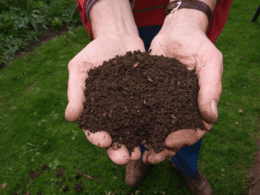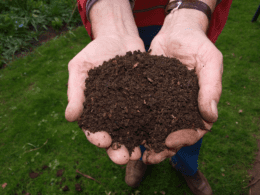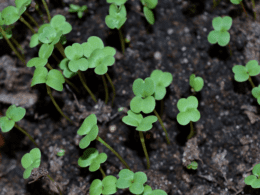Are you looking for a way to add more nutrients to your diet? Sprouts and microgreens are both great options, but do you know the difference between them?
Sprouts are quick to grow and can be ready to eat in just a few days. They are the shoots that grow from seeds, but they are harvested before they have a chance to mature into full-grown plants.
On the other hand, microgreens are vegetable or herb seedlings that are left to mature through their first set of leaves. They are more mature than sprouts and absorb nutrients from the soil, making them a healthier choice.
If you are looking for a way to grow your own nutritious food at home, both sprouts and microgreens can be easily grown indoors. However, it’s important to know which one packs more nutrients.
While both are a good source of nutrients and add flavor and texture to your dishes, microgreens are more mature and have a higher concentration of nutrients. So, if you want to maximize the nutritional benefits of your home-grown greens, microgreens are the way to go.
In this article, we will explore the differences between sprouts and microgreens and help you decide which one is the best choice for you.
Quick Takeaways
- Sprouts and microgreens are different in terms of their growth medium and maturity level.
- Sprouts do not require soil to grow and can be harvested within a few days, while microgreens are grown in soil and harvested after the first set of leaves appear.
- Microgreens offer a higher nutritional value than sprouts due to their more mature state and absorption of nutrients from the growing medium.
- Both sprouts and microgreens offer a wide range of flavors, textures, and nutrients and can be grown at home.
Sprouts Characteristics
You’ll be interested to know that sprouts don’t require soil to grow and can be a quick source of nutrients due to their short growth period. Sprouts are shoots that burst from a seed shell during germination and grow in only a few days. They add beneficial protein, fiber, enzymes, antioxidants, and other trace nutrients to your diet. Sprouts are a great addition to a plant-based diet, as they’re a good source of plant-based protein.
Alfalfa beans are commonly used to grow sprouts, but other seeds and beans can also be used. Incorporating sprouts into your meals is easy. You can add them to salads, sandwiches, wraps, and smoothies. They have a firm outer texture, but the inside of the shoot is very watery.
Alfalfa sprouts have a very mild taste, while beet sprouts are dark red or pink with a sweet, earthy flavor. Broccoli sprouts tend to have a nutty flavor with a hint of spiciness. Keep raw sprouts in the fridge and never eat sprouts that smell bad or have a “rusty” appearance. Cooking sprouts should kill bacteria.
Sprouts are a great way to add nutrients to your diet, so give them a try!
What Are the Benefits of Using a Greenhouse for Growing Sprouts and Microgreens?
A hoop house and greenhouse comparison reveals the numerous benefits of using a greenhouse for growing sprouts and microgreens. Greenhouses offer controlled environments that protect plants from extreme weather conditions while providing ample sunlight. They allow year-round cultivation, ensure optimal temperature and humidity levels, and offer better pest and disease control. Additionally, greenhouses offer increased production and the ability to experiment with different varieties and techniques.
Microgreens Characteristics
To grow microgreens, simply plant vegetable or herb seeds in a soil medium and allow them to mature through the plant’s cotyledon growth stage. Microgreens are harvested after the first set of real leaves begin to form. They come in a wide array of colors and ranges of flavors, making them a popular addition to salads, sandwiches, and other dishes.
Not only do microgreens add flavor and texture to your meals, but they also offer numerous health benefits. Microgreens contain high levels of vitamins, minerals, and antioxidants, making them beneficial for skin health.
Some of the best microgreen varieties for culinary use include radish, sunflower, and pea microgreens, each with their own unique flavor profile.
So why not try growing your own microgreens at home and enjoy their numerous health benefits?
Nutritional Differences
When choosing between sprouts and microgreens, it’s important to consider their nutritional differences. While both offer health benefits, microgreens tend to have higher levels of vitamins and minerals since they are more mature and absorb more nutrients from the soil. For example, microgreens such as kale and broccoli can contain up to 40 times the nutrients of their mature counterparts.
In terms of culinary uses, both sprouts and microgreens can add flavor, texture, and nutrition to dishes. However, microgreens are often used as a garnish or added to salads, while sprouts are commonly used in sandwiches and wraps.
Ultimately, incorporating both sprouts and microgreens into your diet can provide a variety of nutrients and health benefits.
Growing at Home
If you want to grow your own nutrient-rich greens in the comfort of your own home, there are a few things you should know.
Growing techniques for sprouts and microgreens differ, but both can be easily grown indoors with minimal space.
To grow sprouts, simply rinse the seeds and soak them in water for a few hours. Then, place them in a jar with a mesh lid, and rinse them twice a day. Within a few days, you’ll have fresh, healthy sprouts ready to eat.
Growing microgreens requires a bit more effort, but the benefits of homegrown produce are worth it. Start by filling a tray with soil and spreading the seeds evenly. Cover the tray with a lid and place it in a bright, sunny spot. Water the seeds regularly, and within a week or two, you’ll have a tray of vibrant, flavorful microgreens to add to your meals.
Homegrown sprouts and microgreens are a great way to add nutrients to your diet. Growing them at home is easy, cost-effective, and rewarding.
Frequently Asked Questions
Are there any safety concerns with consuming sprouts or microgreens?
When it comes to food safety, it is important to properly handle and clean sprouts and microgreens. While both offer nutritional value, sprouts have a higher risk of bacterial contamination. Always store and handle them carefully to reduce the risk of foodborne illness.
Can sprouts or microgreens be grown in hydroponic systems?
You can grow hydroponic sprouts and microgreens, which are both nutrient-rich. Microgreens absorb nutrients from the growing medium and offer potassium, iron, and more. Hydroponic sprouts grow in water and add protein, fiber, and enzymes to your diet.
How do you know when sprouts or microgreens are ready to harvest?
To determine when your sprouts or microgreens are ready to harvest, look for the appearance of the first set of true leaves. Harvesting techniques vary, but both offer a high nutrient density comparison. Always prioritize safety by checking for any signs of spoilage.
Can different types of seeds be mixed together to grow sprouts or microgreens?
You can mix different types of seeds to grow sprouts or microgreens. Nutrient comparison of mixed seed sprouts or microgreens depends on the types of seeds used. Experiment with different combinations to find your favorite flavors and nutritional benefits.
What are some creative ways to incorporate sprouts or microgreens into meals?
Looking for creative meal ideas that pack a nutrient punch? Try adding sprouts or microgreens to your dishes! Sprouts are great in sandwiches or salads, while microgreens make a tasty addition to omelettes or stir-fries. Nutrient comparison tips included.









